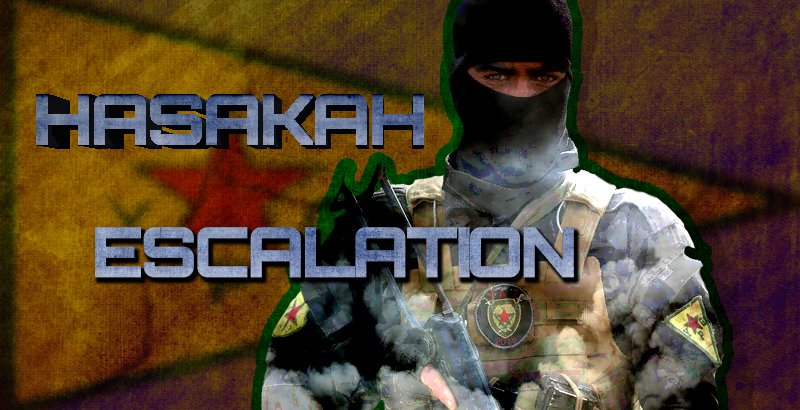
Written by Brian Betts exclusively for SouthFront
August 18th represented an unprecedented day in the Syrian conflict, with the Syrian air force launching bombardments on Kurdish positions after pro-government National Defense Forces (NDF) were attacked by Kurdish police, known as the ‘Asayish, ’ and their allies in the People’s Protection Units (YPG).’
Battles took place in the streets of Hasakah, in north-eastern Syria, after a ceasefire proposal was rejected by the Kurdish authorities. Two Asayish commanders were reported dead from airstrikes by the Syrian Airforce.
During the night, Asayish agents imprisoned family members of the local NDF.
On Friday the 19th, further negotiations towards a ceasefire were dispensed with the YPG leadership released a statement, which would help establish their narrative over the next few days. Intent on blaming the Syrian Government, the YPG leadership made the outrageous claim that the Syrian government was conducting airstrikes to support the Islamic State.
Since the Syrian Airforce attacks in Hasakah had interrupted the Kurds’ focus on their highly successful offensive against the Islamic State in Manbij, the YPG argued that, “This too means the regime sees Daesh’s losses as its own.”
As a result of the conflict and extreme rhetoric of the Kurdish authorities, Arab, Christian and Assyrian fighters abandoned their positions with the US-backed Syrian Democratic Forces (SDF) and joined up with elements of the NDF in the Geweran neighborhood.
In the evening, NDF forces, backed by armor, pushed towards the city center of Hasakah, claiming the New Hospital and Amal. The pro-government militias managed to capture 14 Asayish fighters.
On Saturday the 20th, the Syrian air force launched further airstrikes against Kurdish positions within Hasakah. A pair of Syrian air force SU-24s bombed a target within Hasakah where the US-backed coalition and their direct charges in the YPG claimed, “Elite troops are training and supporting the Kurdish People’s Protection Units (YPG) in the area.”
In response to the Syrian air strikes, another first in the conflict occurred when the US coalition scrambled fighters to counter the SU-24s. The US coalition has since threatened to engage any further government air forces operating in the skies over Hasakah. The virtual ‘no-fly-zone’ is illegal because the US coalition has not received explicit international approval for its establishment.
The YPG leadership also released its second statement on the skirmishes in Hasakah. Besides reinforcing the notion that the Syrian government was supporting the survival of the Islamic State, the YPG offered their ‘casus belli.’
The YPG justified the initial assault on NDF forces because, in their words, the Syrian government was responsible for ‘abandoning’ residents when they lost ground to the Islamic State in the first Battle of Hasakah, in June of 2015. The YPG statement read, “We in the People’s Defense Units, as we liberated the region from Al-Nusra and Daesh, we will secure it from the terror of the Syrian regime as well.”
On August 21, reports appeared that the YPG and the Asayish made a ceasefire agreement with the NDF. In the evening, the situation in the city was more or less calm.
Next day, on August 22, it became clear that the attempts to set up a ceasfire agreement failed and clashes resumed in the city.
The true intent of the initial Kurdish attack against Arab militias should be clear, however. With the establishment of the Rojava, or the so-called de facto autonomous region, Syrian Kurdistan, the pocket of Arab militias in Hasakah represents a force to counter this land grab.
While the precision air strikes of the Syrian air force would quickly open up a buffer and breathing room for their allied forces in southern Hasakah, the imposed no-fly-zone over the city will cripple the legitimate government’s efforts to protect its civilians and fighters.






But that could possibly be interpreted as ethnic cleansing by the Kurds… hence a war crime.
This is a very old trick popular with Western governments. They are using the Kurds, hoping to provoke a Syrian or Russian response they can take advantage of. If they can get either to kill some American advisors there, they will be quite pleased. Likewise, if they can get Russia and Syria to disagree over how to respond, that will be advantageous. Even what they have done so far, using US aircraft to cause Syrian aircraft to withdraw is seen as imposing their will and challenging Syrian/Russian control. From their perspective, it’s a perfect gambit, because any likely response by Syrian and Russia is seen as potentially advantageous to their plans.
People in Washington’s foreign policy and intelligence establishment are frustrated because they have failed to get the president to behave as provocatively as they would like, and the military isn’t very supportive of their twisted schemes either, so they need someone else to stir the coals.